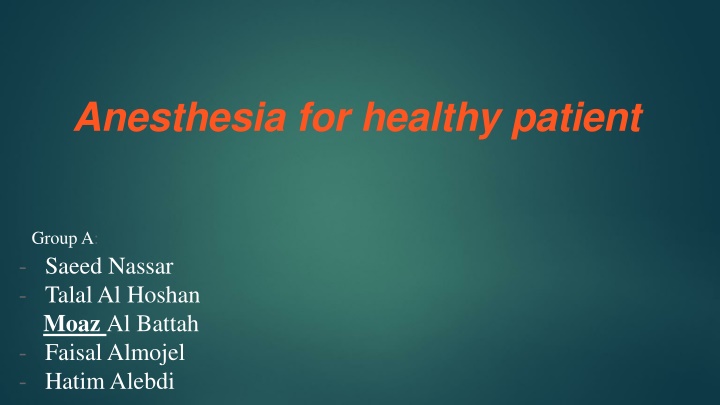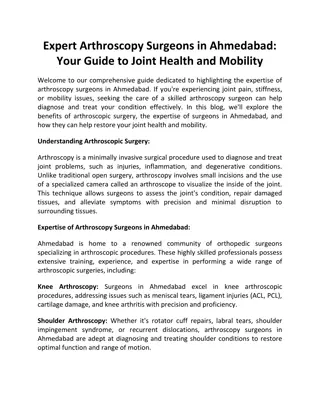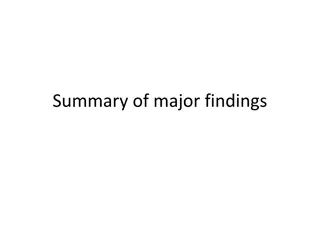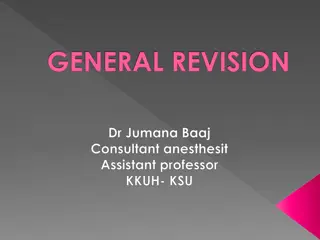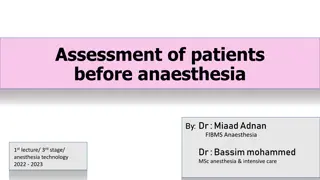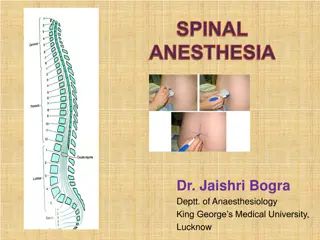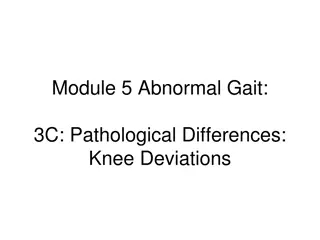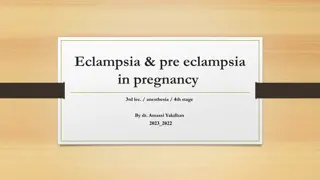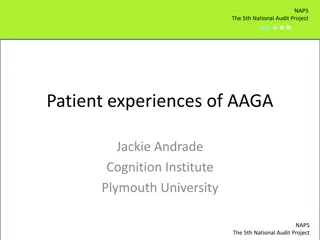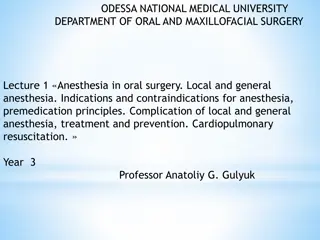Anesthesia Preparation and Airway Assessment for Knee Arthroscopy Patient
An overview of preparing a diabetic patient for knee arthroscopy surgery, including considerations for anesthesia, diabetes management, and airway assessment. The patient in this case study has a torn meniscus and is categorized as ASA Class 2. Steps to ensure optimal diabetes control, preoperative insulin management, and assessing airway risks are discussed.
Download Presentation

Please find below an Image/Link to download the presentation.
The content on the website is provided AS IS for your information and personal use only. It may not be sold, licensed, or shared on other websites without obtaining consent from the author.If you encounter any issues during the download, it is possible that the publisher has removed the file from their server.
You are allowed to download the files provided on this website for personal or commercial use, subject to the condition that they are used lawfully. All files are the property of their respective owners.
The content on the website is provided AS IS for your information and personal use only. It may not be sold, licensed, or shared on other websites without obtaining consent from the author.
E N D
Presentation Transcript
Anesthesia for healthy patient Group A: - Saeed Nassar - Talal Al Hoshan Moaz Al Battah - Faisal Almojel - Hatim Alebdi
Case :3 A 52-year-old man has had progressive knee pain with swelling, His orthopedic surgeon has tentatively diagnosed a torn meniscus, and recommended an arthroscopy as an outpatient. The patient has had no major illnesses other than the typical childhood diseases. He has had no previous operations or anesthetics, nor a family history of problems with anesthesia. He has no allergies to medications, does not smoke, diabetics on oral medication blood sugar is controlled . His laboratory results and physical examination by an internist were all normal. He has had nothing to eat or drink since he went to bed last night.
- What is ASA status?
According to the previous ASA classification table this patient in which grade : He is on grade 2 of ASA Classification.
How will you prepare a diabetic patient for surgery ? Determine the type of diabetes and its management . it is important to confirm the form of diabetes present, as patients with type 1 diabetes must continue a basal rate insulin replacement preoperatively while patients on oral hypoglycemics should stop using them 1 day before surgery Ensure that the patient s diabetes is well controlled . Ensure that the patient is capable of managing their diabetes after discharge from hospital . Consider the presence of complications of diabetes that might be adversely affected by or that might adversely impact upon the outcome of the proposed procedure .
On examination, the patient weighs 75 Kg and is 182 cm tall. His neck appears to be flexible and mobile. He opens difficulty, and with his head extended and tongue protruding, his uvula is completely visible. his mouth without
Discuss the airway assessment for this patient? History Past anesthetic history Surgery/radiotherapy to head and neck. Obstructive sleep apnea (OSA) Conditions affecting tongue size (e.g. acromegaly, infections, tumors( Conditions affecting neck mobility (e.g. ankylosing spondylitis, infections, tumors.) Conditions affecting mouth opening (e.g. temporomandibular joint dysfunction )
Discuss the airway assessment for this patient? - LEMON criteria L Look externally E Examination M Mallampati O Obstruction N Neck mobility
Discuss anesthesia plan for this patient - 1) Pre-Operative Management: Explain the side effects preoperative assessment clinic Anesthetic consent should be taken. Discuss types of anesthesia
2) Intra-Operative Management: Before moving into the operating theater At the OR Airway must be secured (e.g. with an LMA or endotracheal tube) Then further motoring/interventions are performed (e.g. nasogastric tube urinary catheter insertion occur, if indicated.) To establish IV access. Apply monitors: ECG. Pulse Oximeter non- invasive blood pressure monitoring
3) Post Operative Management: Extubated in the operating theater (and an oropharyngeal airway inserted if needed.( Transferred to the recovery room with an LMA still in situ. All patients receive supplemental oxygen during transfer. End Of Operation 1. patient's name and age. 2. operation details 3. blood loss 4. analgesia given 5. antiemetics given 6. Antibiotics 7. thromboprophylaxis In Recovery Room 1.Awake and in complete control of airway reflexes . 2.Pain free. 3. No/minimal nausea and vomiting. 4. No/minimal bleeding from surgical site. 5. Normothermic. Leave Recovery Room?
What is the check list for sign in and time out?
Discuss the safety features of anesthesia machine Non-interchangeable screw threads (NISTs) prevent the incorrect pipeline gas being connected to the machine inlet A pin index system is used to prevent incorrect cylinder connection. Pressure reducing valves/regulators and flow restrictors to prevent barotrauma The oxygen failure warning alarm is pressure driven and alerts of imminent pipeline or cylinder failure Interlocking vaporizers on the back bar prevent two anesthetic vapors from being given simultaneously
Discuss the safety features of anesthesia machine Flow delivered through the anaesthetic machine is displayed by a bobbin within a rotameter to allow accurate gas delivery. Hypoxic guard: the O2 and N2O control knobs are linked, preventing <25% O2 being delivered when N2O is used. Emergency oxygen flush: when pressed, oxygen bypasses the back bar and is 35 < delivered to the CGO (common gas outlet) atL/min
Discuss the safety features of anesthesia machine Suction: generated suction is used to clear airway- pressure-adjustable negative secretions/vomit and must be available for all cases Scavenged gases are usually vented to the atmosphere. Scavenging tubing has a 30 ) wider boremm), preventing accidental connection to breathing circuits. Ventilator alarms warn of high and low pressure.
References : - https://www.asahq.org/resources/clinical-information/asa-physical-status-classification-system - PERI-OPERATIVE DIABETES MANAGEMENT GUIDELINES AUSTRALIAN DIABETES SOCIETY 2012 - Anesthesia At a Glance , Julian Stones and William Fawcett. 2013
